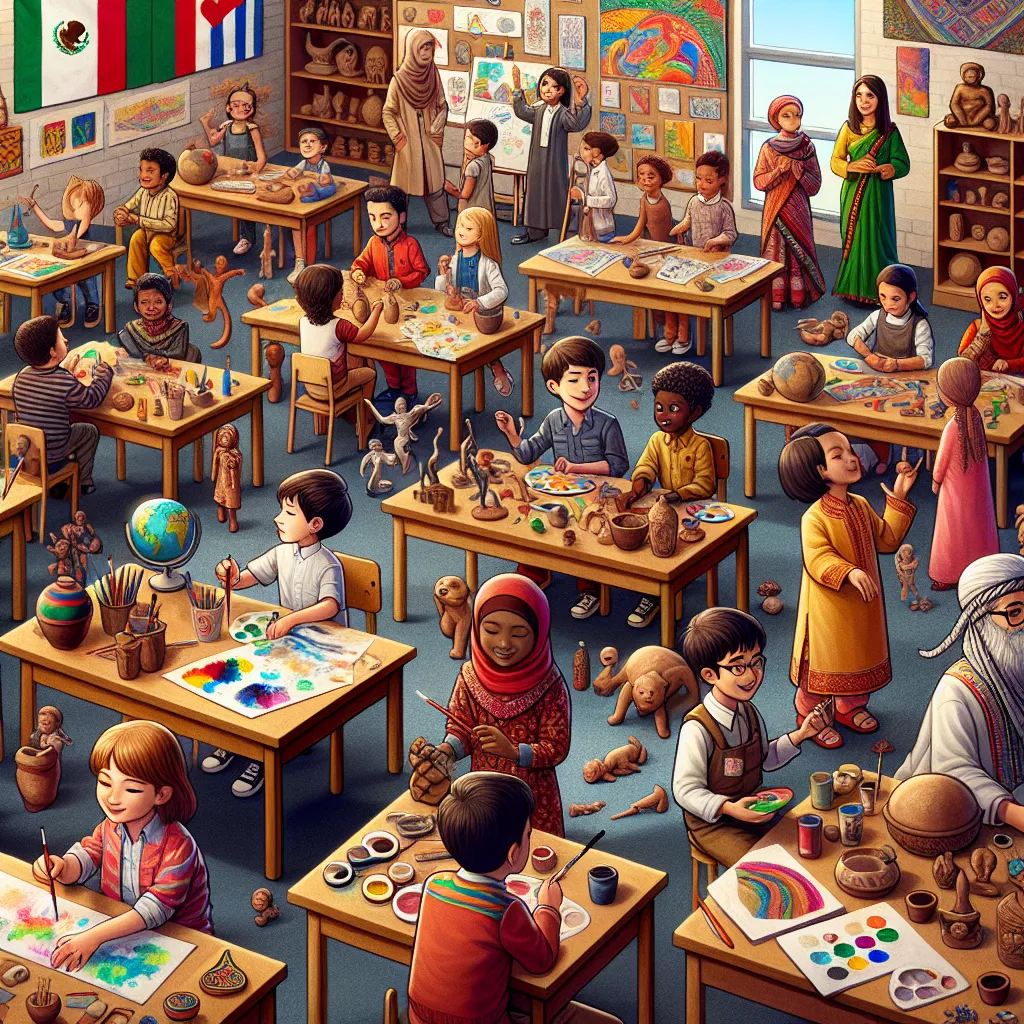The IELTS Reading section assesses your ability to comprehend complex texts and answer questions accurately. Today, we’ll focus on a topic that has been gaining prominence in recent years: “The role of art and culture in education.” This subject has appeared in various forms in past IELTS exams and, given its increasing relevance in modern education systems, it’s likely to resurface in future tests. Let’s dive into a practice passage that will help you sharpen your reading skills while exploring this fascinating theme.
Nội dung bài viết
 Art and Culture in Education
Art and Culture in Education
Practice Passage: The Transformative Power of Arts and Culture in Education
Text
Arts and culture have long been considered peripheral subjects in many educational systems, often overshadowed by the emphasis on science, technology, engineering, and mathematics (STEM) disciplines. However, a growing body of research suggests that integrating arts and cultural education into the curriculum can have profound benefits for students’ overall development and academic performance.
One of the primary advantages of incorporating arts and culture into education is the enhancement of creativity and critical thinking skills. When students engage in artistic activities, they are encouraged to think outside the box, experiment with different ideas, and express themselves in unique ways. This creative process stimulates cognitive flexibility and problem-solving abilities, which are valuable skills applicable across various academic disciplines and real-world situations.
Moreover, arts and cultural education foster emotional intelligence and empathy. Through exposure to diverse art forms and cultural expressions, students develop a deeper understanding of different perspectives and experiences. This heightened awareness of others’ emotions and viewpoints contributes to improved social skills and cultural competence, which are increasingly important in our globalized world.
The integration of arts and culture into education also has a positive impact on academic performance in other subjects. Studies have shown that students who participate in arts programs tend to perform better in reading, writing, and mathematics. This correlation can be attributed to the development of cognitive skills such as pattern recognition, spatial reasoning, and abstract thinking, which are cultivated through artistic practices.
Furthermore, arts and cultural education play a crucial role in preserving and promoting cultural heritage. By introducing students to traditional art forms, music, dance, and literature from various cultures, educational institutions help maintain cultural diversity and foster a sense of identity and belonging among students from different backgrounds.
The benefits of arts and cultural education extend beyond the classroom. Students who engage in these subjects often develop improved self-confidence and self-expression skills. These attributes are valuable in personal and professional contexts, contributing to better communication abilities and a stronger sense of individuality.
Despite the evident benefits, many educational systems still struggle to fully integrate arts and culture into their curricula. Budget constraints, standardized testing pressures, and a lack of qualified instructors are common challenges faced by schools attempting to implement comprehensive arts and cultural programs.
To address these issues, some educational institutions have adopted innovative approaches. For instance, arts integration models incorporate artistic elements into core subject lessons, allowing students to explore academic concepts through creative mediums. This approach not only enhances engagement but also provides a more holistic learning experience.
Additionally, partnerships between schools and cultural institutions, such as museums and theaters, have proven successful in enriching students’ exposure to arts and culture. These collaborations often involve field trips, artist-in-residence programs, and interactive workshops that complement classroom learning.
As we move further into the 21st century, the role of arts and culture in education is likely to become even more significant. The rapidly changing global landscape demands a workforce equipped not only with technical skills but also with creativity, cultural awareness, and adaptability – qualities that are nurtured through arts and cultural education.
In conclusion, the integration of arts and culture into education offers multifaceted benefits that contribute to students’ cognitive, emotional, and social development. By recognizing and embracing the transformative power of these disciplines, educational systems can better prepare students for the complex challenges and opportunities of the modern world.
Questions
-
Which of the following is NOT mentioned as a benefit of incorporating arts and culture into education?
A) Enhanced creativity
B) Improved critical thinking skills
C) Increased physical fitness
D) Better academic performance in other subjects -
According to the passage, arts and cultural education contribute to the development of:
A) Emotional intelligence
B) Empathy
C) Cultural competence
D) All of the above -
The text suggests that arts integration models:
A) Replace core subjects with artistic activities
B) Incorporate artistic elements into core subject lessons
C) Focus solely on traditional art forms
D) Eliminate the need for standardized testing -
What challenge do educational systems face in integrating arts and culture into their curricula?
A) Lack of student interest
B) Excessive funding
C) Budget constraints
D) Too many qualified instructors -
The passage implies that arts and cultural education is becoming more important due to:
A) The declining interest in STEM subjects
B) The changing demands of the global workforce
C) A surplus of art teachers
D) Decreased use of technology in society -
According to the text, partnerships between schools and cultural institutions often involve:
I. Field trips
II. Artist-in-residence programs
III. Interactive workshopsA) I and II only
B) II and III only
C) I and III only
D) I, II, and III -
The author suggests that arts and cultural education helps students develop skills that are:
A) Only useful in artistic careers
B) Irrelevant in the modern world
C) Valuable in both personal and professional contexts
D) Exclusively academic in nature -
Which of the following statements is true according to the passage?
A) Arts and culture have always been central to most educational systems.
B) Students who participate in arts programs tend to perform worse in other subjects.
C) Arts and cultural education help preserve and promote cultural heritage.
D) The benefits of arts education are limited to the classroom environment. -
The text indicates that arts and cultural education contribute to the development of:
A) Pattern recognition
B) Spatial reasoning
C) Abstract thinking
D) All of the above -
What does the author imply about the future role of arts and culture in education?
A) It will become less important as technology advances.
B) It will remain unchanged from its current status.
C) It will likely become more significant in preparing students for future challenges.
D) It will be completely replaced by STEM subjects.
Answers and Explanations
-
C) Increased physical fitness
Explanation: The passage does not mention physical fitness as a benefit of arts and cultural education. It focuses on cognitive, emotional, and social benefits. -
D) All of the above
Explanation: The text explicitly mentions that arts and cultural education foster emotional intelligence, empathy, and cultural competence. -
B) Incorporate artistic elements into core subject lessons
Explanation: The passage states, “arts integration models incorporate artistic elements into core subject lessons.” -
C) Budget constraints
Explanation: The text mentions “Budget constraints” as one of the challenges faced by schools in implementing arts and cultural programs. -
B) The changing demands of the global workforce
Explanation: The passage suggests that the global landscape demands a workforce with creativity, cultural awareness, and adaptability, which are nurtured through arts and cultural education. -
D) I, II, and III
Explanation: The text mentions all three – field trips, artist-in-residence programs, and interactive workshops – as components of partnerships between schools and cultural institutions. -
C) Valuable in both personal and professional contexts
Explanation: The passage states that the attributes developed through arts education “are valuable in personal and professional contexts.” -
C) Arts and cultural education help preserve and promote cultural heritage
Explanation: The text explicitly states that arts and cultural education play a crucial role in preserving and promoting cultural heritage. -
D) All of the above
Explanation: The passage mentions pattern recognition, spatial reasoning, and abstract thinking as cognitive skills developed through artistic practices. -
C) It will likely become more significant in preparing students for future challenges
Explanation: The author concludes by suggesting that the role of arts and culture in education is likely to become even more significant in preparing students for future challenges.
Common Mistakes
When tackling reading passages like this one, students often make the following mistakes:
-
Overlooking key phrases: Pay attention to phrases like “according to the passage” or “the text suggests,” which indicate that the answer should be directly based on the information provided.
-
Making assumptions: Avoid bringing in outside knowledge or personal opinions. Focus solely on the information presented in the text.
-
Misinterpreting negatives: Be careful with questions that ask for what is NOT mentioned or is FALSE. These require careful elimination of correct statements.
-
Rushing through the text: Take time to understand the main ideas and supporting details. Skimming too quickly can lead to misunderstandings.
-
Ignoring context: Consider the context of words and phrases within the passage. Their meaning may be specific to how they’re used in the text.
Vocabulary
Here are some challenging words from the passage, along with their definitions:
- Peripheral (adjective) – /pəˈrɪf.ər.əl/ – of secondary or minor importance
- Cognitive (adjective) – /ˈkɒɡ.nə.tɪv/ – related to the process of thinking or perceiving
- Empathy (noun) – /ˈem.pə.θi/ – the ability to understand and share the feelings of another
- Competence (noun) – /ˈkɒm.pɪ.təns/ – the ability to do something successfully or efficiently
- Integration (noun) – /ˌɪn.tɪˈɡreɪ.ʃən/ – the act of combining or adding parts to make a unified whole
- Curricula (noun) – /kəˈrɪk.jʊ.lə/ – plural of curriculum; the subjects comprising a course of study
- Holistic (adjective) – /həʊˈlɪs.tɪk/ – characterized by the belief that the parts of something are interconnected and can be explained only by reference to the whole
Grammar Focus
Pay attention to the following grammatical structures in the passage:
-
Passive voice: “Arts and culture have long been considered peripheral subjects…”
This structure is used to emphasize the action rather than the doer of the action. -
Present perfect tense: “Studies have shown that students who participate in arts programs…”
This tense is used to describe past actions with present relevance. -
Comparative structures: “…more holistic learning experience.”
These are used to compare different concepts or ideas. -
Conditional sentences: “By recognizing and embracing the transformative power of these disciplines, educational systems can better prepare students…”
This structure is used to express potential outcomes based on certain conditions.
Tips for IELTS Reading Success
-
Time management: Practice reading passages and answering questions within the allotted time. Aim to spend about 20 minutes on each passage.
-
Active reading: Underline key information and make brief notes as you read. This helps with comprehension and locating information quickly.
-
Develop your vocabulary: Regularly learn new words and their usage in context. This will help you understand complex texts more easily.
-
Practice different question types: Familiarize yourself with various IELTS question formats to improve your speed and accuracy.
-
Read widely: Expose yourself to a variety of texts on different topics to broaden your knowledge and improve your reading speed.
-
Use context clues: If you encounter unfamiliar words, try to deduce their meaning from the surrounding context.
-
Stay focused: Concentrate on the task at hand and avoid getting distracted by difficult vocabulary or complex ideas. Keep moving forward.
-
Review your answers: If time allows, quickly check your answers for any obvious mistakes or overlooked details.
By following these tips and regularly practicing with passages like the one above, you’ll be well-prepared for the IELTS Reading section. Remember, consistency is key in improving your reading skills and achieving a high score on the IELTS exam.
To further enhance your IELTS preparation, you might find it helpful to explore related topics such as the importance of diversity and inclusion in the workplace and how to foster innovation in education. These topics often intersect with the role of art and culture in education and can provide valuable insights for your IELTS study.


